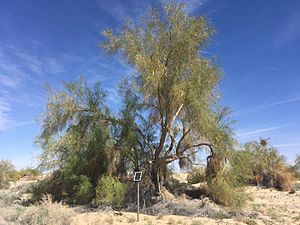Pterotermes facts for kids
Quick facts for kids Pterotermes |
|
|---|---|
| Scientific classification | |
| Genus: |
Pterotermes
|
| Species: |
occidentis
|
| Synonyms | |
|
|
Pterotermes is a special kind of genus of termites. This means it has only one species in it. That species is called Pterotermes occidentis. This termite lives in very dry places, like the Sonoran Desert. You can find it in the southwestern United States, Baja California, and Mexico. It eats dry wood and lives its whole life inside a single piece of timber.
Contents
Meet the Pterotermes occidentis Termite
Pterotermes occidentis is the biggest drywood termite found in the deserts of the southwestern USA. It's considered a very old type of termite. Its different groups, or "castes," are not always easy to tell apart.
How They Grow and What They Do
Termite eggs hatch into tiny young termites called nymphs. These nymphs grow into "pseudergates." Pseudergates act like workers in the colony. They do most of the work before changing into either soldiers or winged adults.
What They Look Like
The winged adult termites have big, black compound eyes. They also have white spots right above their eyes. Their body, called the thorax and abdomen, is orange. The part behind their head, called the pronotum, is quite flat. It doesn't curve down much at the sides.
The soldier termites have a round, flat-topped head. They have large "wingbuds," which are like tiny undeveloped wings. Their pronotum is very big and has a V-shaped notch at the front. This notch helps tell them apart from other termites in the area. They are also special because they have clear eyespots.
Life in the Desert: Pterotermes occidentis Ecology
After a special mating flight, individual adult termites look for a good spot. They search for a hole or crack in dry, dead wood. They don't drill new holes. Instead, they might make an existing hole a bit bigger. Later, another termite might join them in the hole. After a few days, they seal the entrance with a plug made of their waste.
Building a Colony
Starting a termite colony is a very slow process. After a year, a new nest might have anywhere from zero to twelve young termites. The colony grows by making many tunnels and rooms, called galleries. These galleries are usually kept clean.
The termites make small "kick holes" to the outside. Through these holes, they push out their waste pellets. After cleaning, they seal the holes again. Old, empty rooms might be filled with waste pellets and the dried-up bodies of termites that have died.
What They Eat and How They Survive
These termites don't like moisture at all. They only eat dry wood. They get all the water they need from the wood they eat. The adult termites fly around to find mates in July and August.
P. occidentis mostly eats dead branches from the blue palo verde tree. Another type of drywood termite in the Sonoran Desert, Marginitermes hubbardi, mainly eats the remains of saguaro cacti.
Dry wood is a very hard food to get energy from. So, these termites have about forty different tiny living things, called symbiotic microorganisms, in their gut. These tiny helpers break down the wood for them. All P. occidentis colonies have this wide variety of gut helpers. This shows that having many different types of helpers is important for the colony to survive.


